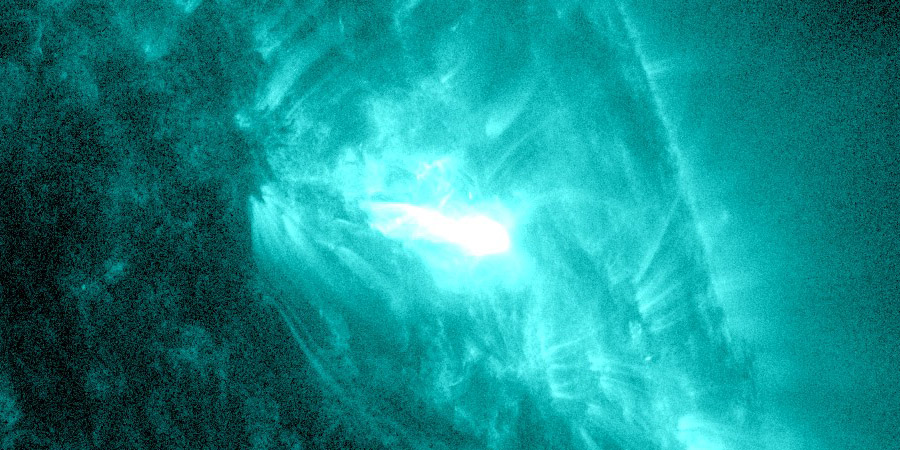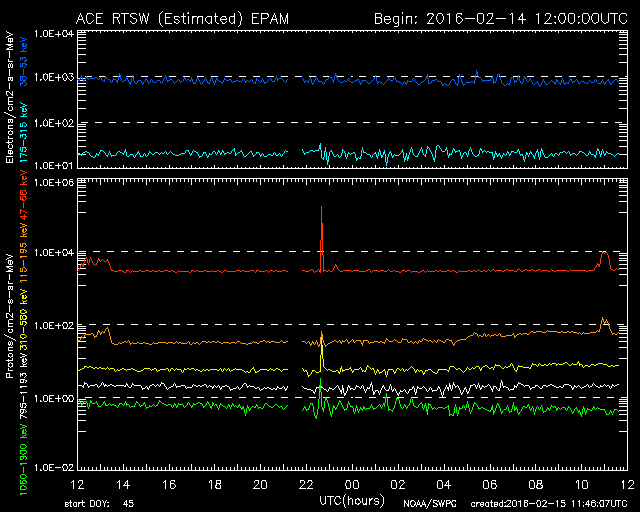M-class solar flares, Where is the CME?
Monday, 15 February 2016 11:59 UTC

Sunspot region 2497 continues to provide us with low-level (R1) M-class solar flares as it rotates towards the west limb.
Today at 11:00 UTC it was the source of an impulsive M1.2 solar flare and yesterday evening at 19:26 UTC it produced an impulsive M1.0 solar flare. Yesterday's M1.0 solar flare was not eruptive and today's M1.2 solar flare will likely also not launch a coronal mass ejection. Sunspot region 2497 is now close the west limb and any future eruptions are likely no longer Earth-directed. It remains a complex Beta-Gamma-Delta sunspot region and more M-class solar flares can not be excluded.
Where is the coronal mass ejection?
A coronal mass ejection was expected to arrive early today but there are no clear signs in the solar wind data that the plasma cloud has arrived.
While the cloud of solar plasma can still arrive at our planet (it is not uncommon for coronal mass ejection to arrive much earlier or later than expected) it is starting to look like the impact might have been too weak to notice or that it completly missed our planet. A very important tool for advanced space weather enthusiasts is the ACE EPAM plot. This plot shows us the low energy electrons and protons. When a solar flare erupts and sends a coronal mass ejection our way we would normally see an increase in the low energy protons on this plot until the plasma cloud arrives at the ACE satellite. That's when the values reach their highest levels. If you wish to know more we recommend you to read this help article. Let's take a look at EPAM right now. For that you can take a look at the image below. As EPAM looks right now, all the values are flat at background level. This makes us believe the plasma cloud might have missed our planet and there was not an Earth-directed component in the first place. This coronal mass ejection was a very nice wide partial halo coronal mass ejection (270 degrees) that really looked like it would at least gave us a glancing blow so it is strange that it might have missed us. We still recommend you to keep an eye on the solar wind data from ACE today as we can not exclude that there might still be a tiny glancing blow on the cards but our feelings say that it's a lost cause. Space weather can be tricky sometimes!

Image: ACE EPAM plot on 15 February at 11:46 UTC.
So yes, it really is starting to look like this coronal mass ejection might have missed our planet. That is of course not so fun news for us aurora lovers but not all hope is lost. We do have a coronal hole facing Earth right now. Solar wind flowing from this southern hemisphere coronal hole is likely to arrive on Wednesday and cause active geomagnetic conditions. Be sure to read our news article from yesterday in case you wish to know more.
Thank you for reading this article! Did you have any trouble with the technical terms used in this article? Our help section is the place to be where you can find in-depth articles, a FAQ and a list with common abbreviations. Still puzzled? Just post on our forum where we will help you the best we can!
Latest news
Latest forum messages
Support SpaceWeatherLive.com!
A lot of people come to SpaceWeatherLive to follow the Sun's activity or if there is aurora to be seen, but with more traffic comes higher server costs. Consider a donation if you enjoy SpaceWeatherLive so we can keep the website online!

Space weather facts
| Last X-flare | 2024/03/28 | X1.1 |
| Last M-flare | 2024/04/19 | M1.0 |
| Last geomagnetic storm | 2024/04/19 | Kp7 (G3) |
| Spotless days | |
|---|---|
| Last spotless day | 2022/06/08 |
| Monthly mean Sunspot Number | |
|---|---|
| March 2024 | 104.9 -19.8 |


